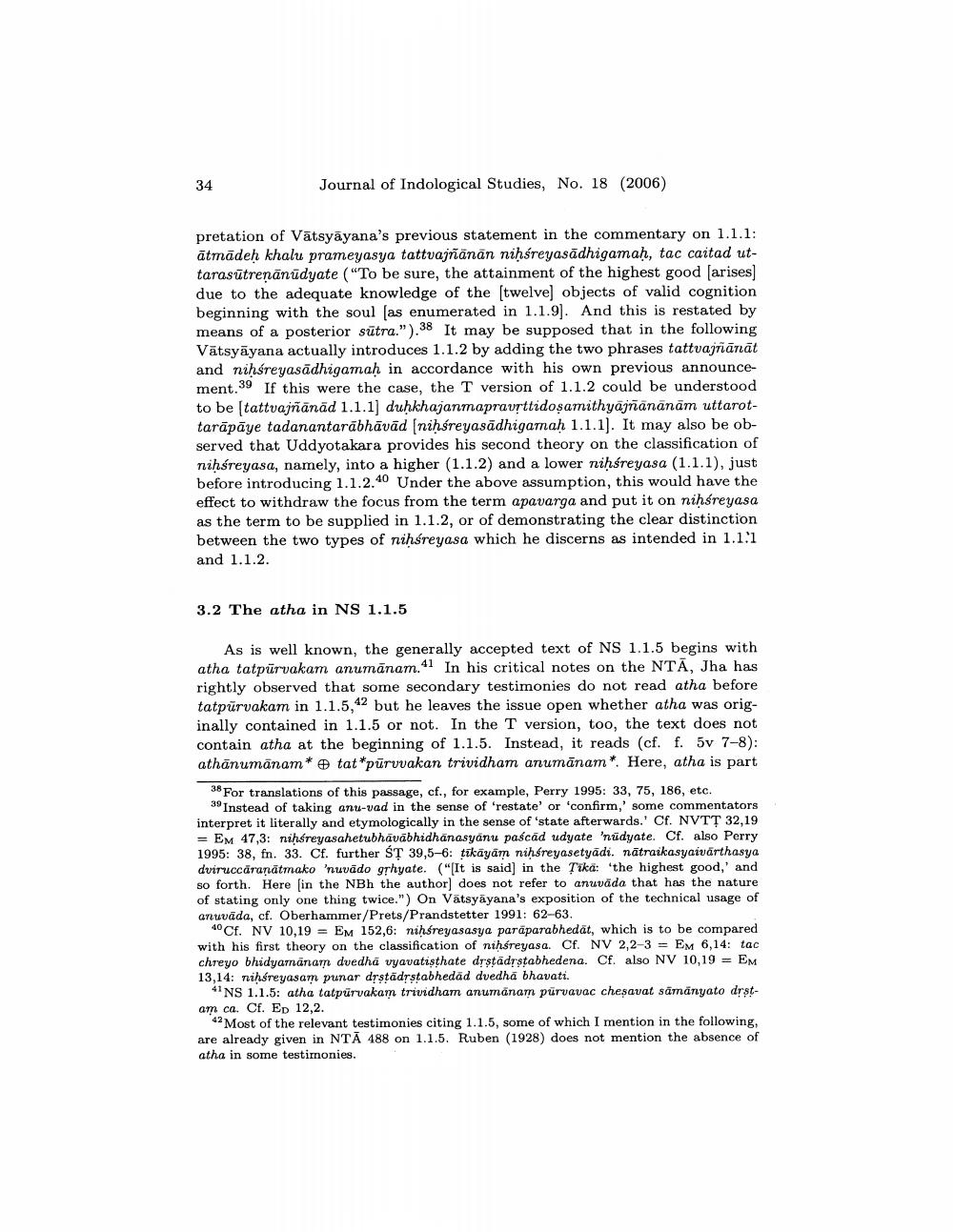________________
Journal of Indological Studies, No. 18 (2006)
pretation of Vātsyāyana's previous statement in the commentary on 1.1.1: ātmādeh khalu prameyasya tattvajñanan nihśreyasādhigamah, tac caitad uttarasütreņānüdyate ("To be sure, the attainment of the highest good (arises) due to the adequate knowledge of the [twelve) objects of valid cognition beginning with the soul (as enumerated in 1.1.9). And this is restated by means of a posterior sūtra.").38 It may be supposed that in the following Vātsyāyana actually introduces 1.1.2 by adding the two phrases tattvajriānāt and nihsreyasādhigamah in accordance with his own previous announcement.39 If this were the case, the T version of 1.1.2 could be understood to be tattvajñānād 1.1.1) duhkhajanmapravsttidosamithyajñanānām uttarottarāpāye tadanantarābhāvād (nihśreyasādhigamah 1.1.1). It may also be observed that Uddyotakara provides his second theory on the classification of nihśreyasa, namely, into a higher (1.1.2) and a lower nihśreyasa (1.1.1), just before introducing 1.1.2.40 Under the above assumption, this would have the effect to withdraw the focus from the term apavarga and put it on nihśreyasa as the term to be supplied in 1.1.2, or of demonstrating the clear distinction between the two types of nihśreyasa which he discerns as intended in 1.1.1 and 1.1.2.
3.2 The atha in NS 1.1.5
As is well known, the generally accepted text of NS 1.1.5 begins with atha tatpūrvakam anumānam.41 In his critical notes on the NTĀ, Jha has rightly observed that some secondary testimonies do not read atha before tatpūrvakam in 1.1.5,42 but he leaves the issue open whether atha was originally contained in 1.1.5 or not. In the T version, too, the text does not contain atha at the beginning of 1.1.5. Instead, it reads (cf. f. 5v 7-8): athānumānam* tat*pūruuakan trividham anumānam*. Here, atha is part
3 For translations of this passage, cf., for example, Perry 1995: 33, 75, 186, etc.
39 Instead of taking anu-vad in the sense of 'restate' or 'confirm,' some commentators interpret it literally and etymologically in the sense of 'state afterwards.' Cf. NVTT 32,19 = EM 47,3: nihsreyasahetubhāvābhidhänasyanu pascad udyate 'nūdyate. Cf. also Perry 1995: 38, fr. 33. Cf. further ST 39,5-6: tīkāyām nihfreyasetyadi. nätraikasyaivarthasya dviruccäranätmako nuvädo grhyate. ("[It is said) in the Tika: 'the highest good,' and so forth. Here in the NBh the author] does not refer to anuväda that has the nature of stating only one thing twice.") On Vätsyāyana's exposition of the technical usage of anuvada, cf. Oberhammer/Prets/Prandstetter 1991: 62-63
40Cf. NV 10,19 = EM 152,6: nihsreyasasya paraparabhedät, which is to be compared with his first theory on the classification of nihśreyasa. Cf. NV 2,2-3 = EM 6,14: tac chreyo bhidyamanam dvedhã vyavatisthate drstädretabhedena. Cf. also NV 10,19 = EM 13,14: nihśreyasam punar drstādrstabhedad dvedha bhavati.
4 NS 1.1.5: atha tatpurvakam trividham anumanam purvavac chesavat samanyato drstam ca. Cf. Ep 12,2
42 Most of the relevant testimonies citing 1.1.5, some of which I mention in the following, are already given in NTA 488 on 1.1.5. Ruben (1928) does not mention the absence of atha in some testimonies.




